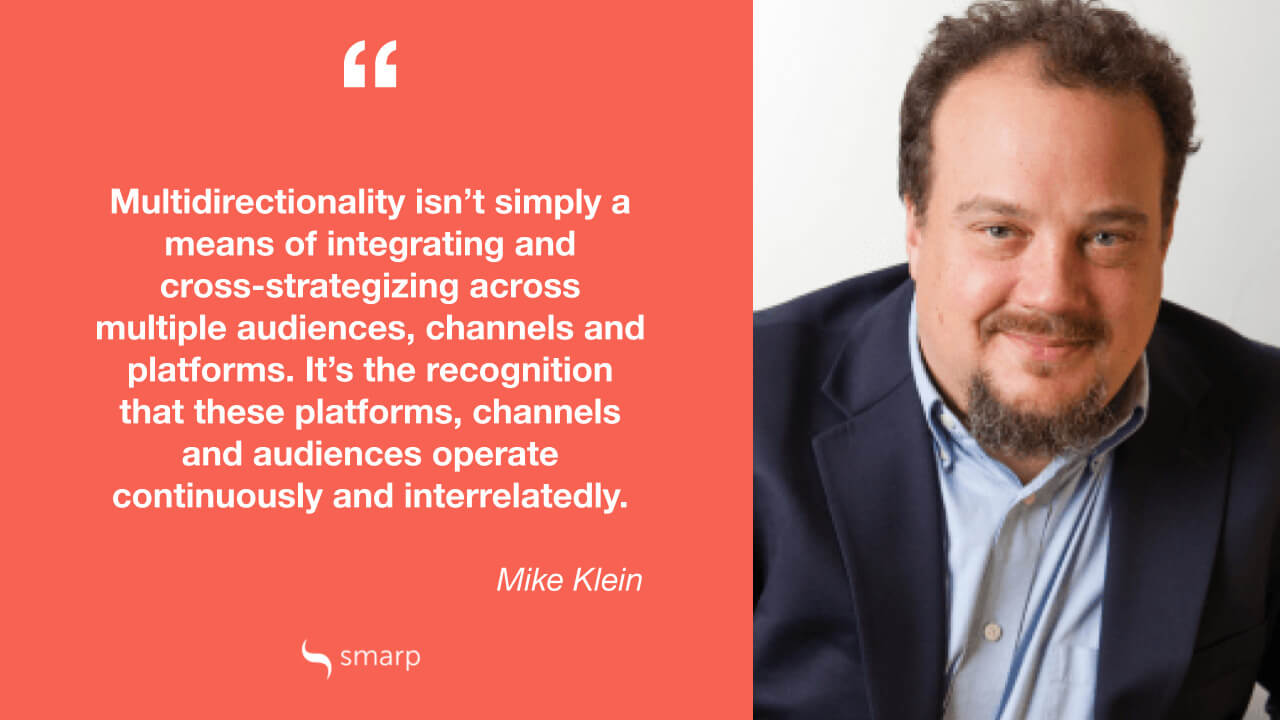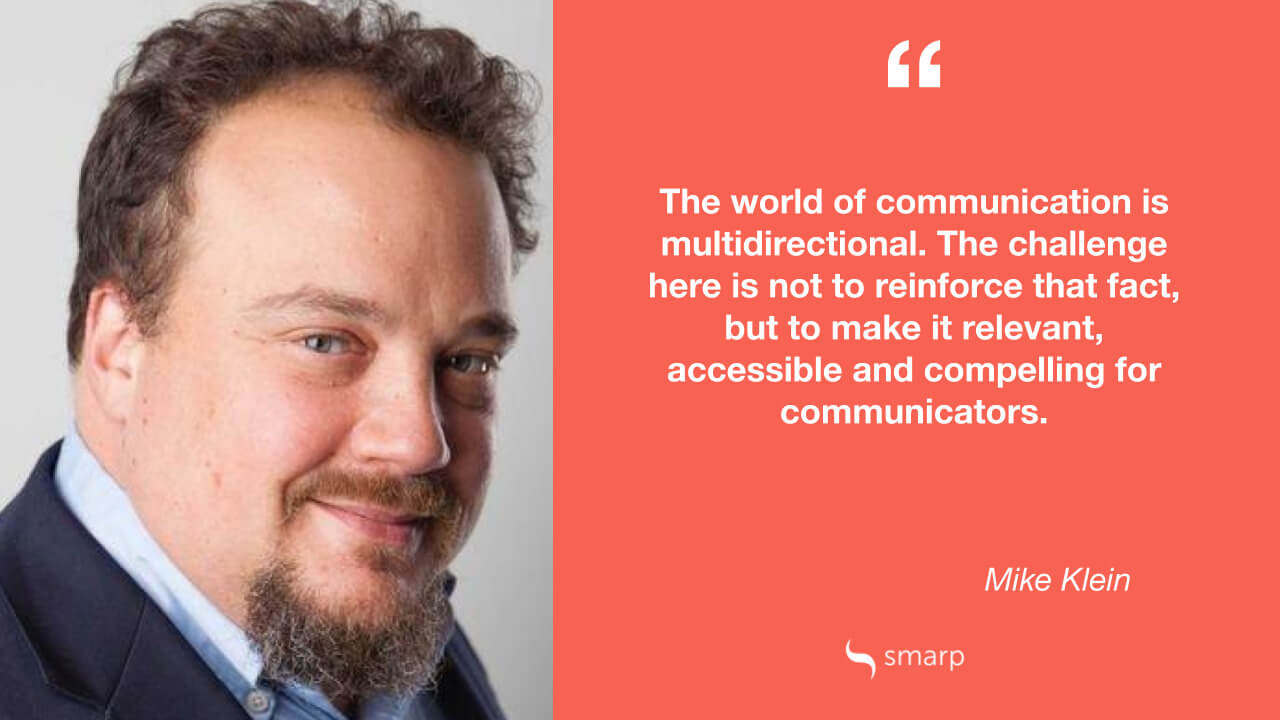One of the biggest challenges facing internal communication has been a legacy 20th-century mindset — a view that communication in a business rightly flows from the top down, and perhaps, under very rare and tightly-managed circumstances, a limited flow in the opposite direction can be tolerated.
That mindset holds that internal communication can be controlled and conducted in isolation from the many other streams of communication that are continually taking place in the societies and communities where a business operates.
💡Download the Skillset Map of a Modern IC Department and learn about the most required leadership skills for modern communication practitioners!
Even though it makes little sense when seen in the context of today’s proliferation of channels, content and conversations, this mindset has by no means been eradicated.
But it is increasingly easy to challenge from different and largely self-evident angles:
- The idea that internal and external communication are converging implies the recognition that employees can be influenced by external as well as internal sources.
- The recognition by “millennial” IC leaders of continuous social and digital communication that connects employees into a multidirectional environment in which they engage with varied internal and external communication streams.
- The emergence of “unofficial” channels like Vault and Glassdoor where employees can confidentially — yet publicly — discuss and debate sensitive internal issues like management quality and pay rates.
- The ability for prospective and employees to learn through Vault, Glassdoor and other channels about the communication culture of the companies they are about to join, and to prepare themselves accordingly.
- The growing popularity of internal communication software platforms that allow employees to communicate with each other and create groups and networks without leadership or editorial intervention.
- The mobility of workerswho have moved from companies that have appropriate tools and strategies to those who are more conservative or resistant.
- The prevalence of personal smartphones and the range of communication and entertainment tools they have available, and the extent to which those tools are used during the workday.
- The viability of social analysis approaches like Organizational Network Analysis that can provide insights into how word-of-mouth flows within companies, and in doing so, validate the notion that effective internal communication can take place outside and beyond hierarchical platforms and processes.
Multidirectionality Is Not a New Concept
As that last point illustrates, internal communication has never simply been top-down or “top-down plus bottom-up,” but has long had strong informal and multidirectional components even when the only alternative system was “word-of-mouth”.

Such components are particularly obvious in organizations that have strong and visible brands, and also in locations (like company towns) where a company is a large and well-known employer and where word-of-mouth has a high degree of credibility.
Multidirectionality, thus, is not a new phenomenon.
Indeed, it’s been the operative way organizations and communities have always communicated. But until the 21st century, it had never really been distinguished. More to the point, the roles of informal, lateral and societal communication, when even noticed, were seen as inconvenient to influence, impossible to control and insufficiently tangible or credible to incorporate into internal communication strategies.
Read on: Company Values: Definition, Importance and Examples
Instead, the prevailing view was to support leaders in hammering home organizational direction. Messaging and delivery was almost exclusively top-down, and frequently one-size-fits-all.
Feedback, when solicited, was usually collected in response to top-down cascading or in intimidating open forums like town hall sessions, rather than as part of a natural communication flow. Even when collected, such feedback was often privately noted rather than publicly acknowledged and acted upon.
Internal Communication — The Shift Towards Multidirectionality
Many organizations continue to hold onto the top-down model.
It retains its attractiveness to organizations that still believe that internal messaging can be tightly and conveniently controlled, to organizations with “boomer-heavy” management teams and workforces, or which believe they lack organizational bandwidth to think about communication moving in multiple directions through different channels.
But rather than retain tight control over their messages, such organizations now risk losing control — or even sufficient influence or credibility — over their own messaging and organizational stories.
It’s important to note that the advent of the Internet in the 1990s was a decisive moment in blowing away the idea that internal communication could be conducted solely through protected one-way and two-way channels.

In essence, the Internet offered a broad platform through which these protected channels could be bypassed and where individuals could make their own connections. First through emails. Then through discussion groups, general social media like LinkedIn, Facebook and Twitter, and now group messaging apps like Whatsapp and websites like Glassdoor.
But the proliferation of platforms and channels did not itself spark a realization that the very playing field of organizational communication had changed.
Instead, organizations thought in terms of “channel strategies” and specifically, in terms of keeping specific channels populated with content of various types of content.
Thinking about “integrated communication” so far has emphasized compatibility and recyclability of customer-facing and employee-facing content rather than looking a the relationships, connections and flows between internal and external players.
Millennials Go Multidirectional
Twenty years into the 21st century, a new generation of leaders begins to pour into internal communication roles that see multidirectionality instinctively.
“We’ve known nothing but the social and digital world,” said Edward Ulrich of Fifth Business.
Another Millennial IC leader working for a US-based industrial company, Veronique van Ede-Lefel adds, “We’re used to integrating information from lots of different sources and directions. We can leverage opportunities quickly and innovatively”.
Multidirectional Communication Is Not Just for Millennials
While, in my view, it’s great to see millennials come into the field who appreciate multidimensionality instinctively, the even-better news is that multidirectional internal communication is for everyone — that every IC professional has the opportunity to thrive and to see their work take on unprecedented impact by taking a multi-directional approach.
Here’s how:
- Multidirectionality gives us the ability to integrate formal and informal, internal and external processes into a coherent planning and strategic framework, so that the bases and directions are acknowledged and covered.
- Because the playing field is so wide and constantly moving, the goal is to identify and prioritize the activities which would have the most positive impact, rather than to try to control all of the channels which may convey information or convene discussions on the given topic.
- Multidirectionality recognizes the role of employees as active participants in the communication process, choosing to receive, reshare, and reposition the information and messages they receive.
- Rather than passive recipients, some may be active participants interacting about the messages on internal and external channels. The notions of influence and advocacy indeed become more coherent and vivid when looked at inside a multidirectional view of communication than as some isolated “nice-to-have” or as some kind of a forced top-down exercise.
- It opens the space for targeting the right messages, to the right people, while also addressing what is going on in their context.
Read on: 8 Employee Engagement Statistics You Need to Know in 2020 [INFOGRAPHIC]
What’s the Bigger Picture?
Multidirectionality isn’t simply a means of integrating and cross-strategizing across multiple audiences, channels and platforms.
It’s the recognition that these platforms, channels and audiences operate continuously and interrelatedly.
In short, it is no less of a shift in thinking as it is to see the world as round and three dimensional as instead of being flat. This is not to say that they all behave in the same way.
External conversations among consumers are built around the nature of the consumer relationship: mainly brand-centric and transactional. Internal conversations tend to be more intense, more comprehensive in terms of the relationships, processes and objectives involved, and in some cases, reflective and integrative of the concerns voiced in consumer conversations.
So, What Do You Need to Win in a Multidirectional World?
Attention and action are the currencies of the multidirectional communication world — that which merits no attention essentially does not exist.
So, the core objective of communication moves from “how can I generate awareness” to “how can I get the attention of the people we need to engage with this content, given everything else competing for that attention?”
Strategically, that requires a shift in thinking away from the “engage everyone equally” mentality that we’ve seen emerge in recent years, and towards one that prioritizes relevance.
Read on: Top 5 Communication Skills and How to Improve Them
Traditional focus on visual attractiveness and message simplicity may come into play, but will likely need to be complemented with off-line peer pressure and perhaps an approach to line manager communication that combines online guidance with offline interaction.
Technically, it means that the drive towards upgrading internal communication platforms and technologies becomes far more important.
Employees engage on many external and public channels with top-shelf consumer-grade technologies, and notice when workplace technologies are not up to scratch.
Improvised and antiquated platforms also make it more difficult to integrate and manage activities across the various directions, and to engage with appropriate degrees of individual targeting and aesthetic impact.
In a Nutshell
The world of communication is multidirectional. That is a fact, and it is substantiated by even a casual realisation of the different internal and external, formal and informal communication flows that move, intersect and ultimately engage and connect people.
The challenge here is not to reinforce that fact, but to make it relevant, accessible and compelling for communicators, and above all, top management.
The key here is the ability to drive communication in a more powerful, focused and relevant way, as opposed to reinforcing a dated and inaccurate view of the world — and getting blamed when it doesn’t work.










